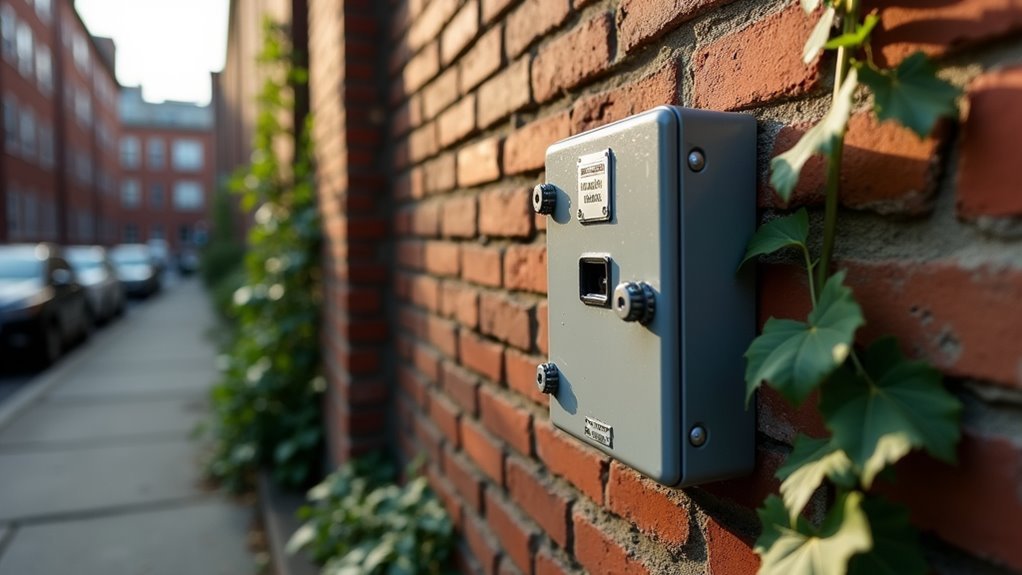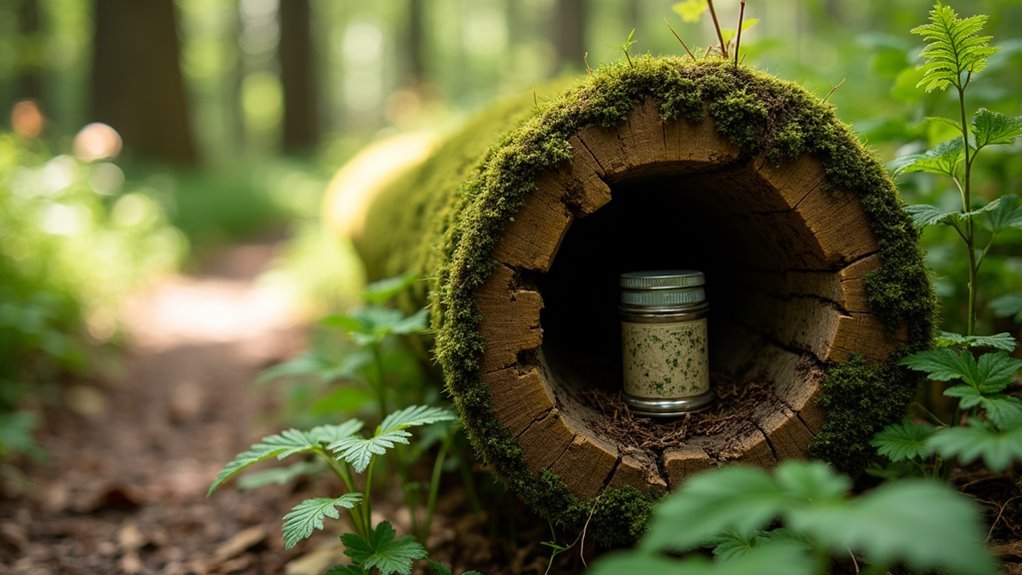Some of the links in this article may be affiliate links. If you make a purchase through these links, we may earn a small commission at no extra cost to you. Thank you.
I’ve been hiding geocaches for years, and I’m still amazed at how creative you can get with placement. You know, it’s not just about stuffing containers under rocks anymore—I’ve tucked them inside fake electrical boxes, hollow fence posts, and even disguised one as chewing gum stuck under a park bench! The secret is thinking like someone who doesn’t want to find it. What unexpected spots might they overlook?
Urban Camouflage: Blending Caches Into City Landscapes

How do you hide something in plain sight?
When it comes to geocaching in urban environments, it’s all about making your cache blend with the city landscape.
I’ve found that integrating containers into existing infrastructure works brilliantly—like those clever flip-out boardwalk rail designs that completely disappear into their surroundings.
For successful urban camouflage, I think you should place your cache near features that make sense, like shorter trees in city parks.
You know, GPS signals can be tricky in urban canyons, so placement matters!
Don’t forget to test your container’s durability against rain and other urban conditions.
Sometimes I’ll even use a decoy cache to enhance the adventure.
Natural Hideaways: Woodland and Park Concealment Strategies
The natural world offers countless perfect hiding spots for geocaches, if you know where to look. In my experience with GPS devices, shorter trees and stumps provide excellent natural camouflage. Before hiding your cache, I’d recommend visiting the location first, as Rietje Swinnen suggests, to really assess if it’s suitable.
Nature offers perfect hideaways for geocaches—stumps and shorter trees provide excellent camouflage if you scout locations properly.
Make sure your container fits precisely in your chosen spot—this is actually essential for woodland concealment.
When I place caches in tree hollows or stumps, I always test their durability against rain and other elements. It’s kind of like—well, you wouldn’t build a house without checking the foundation, right?
Many aspects of trackables and puzzle creation benefit from these natural hideaways, going beyond basic hiding methods while respecting Adventure Lab Guidelines.
Themed Cache Containers: Matching Disguises to Locations

Moving from natural hideaways to the artistry of container design, I’ve found that matching your geocache container to its surroundings isn’t just clever—it’s downright thrilling for those who’ll eventually find it.
I’ve seen everything from Project APE Cache replicas to fake fungi containers that blend perfectly with their woodland homes.
When creating your themed container, think about the cache logs and trackable inventory your container will house.
I once disguised a cache as a boardwalk rail that fooled even experienced geocachers with GPS units and geocaching-related apps!
The best part? You can create decoys that direct seekers to the actual cache nearby.
It’s like creating a mini-adventure within the larger quest—something that sparks those discussions about Global Positioning and different types and additional GPS-based challenges.
Weather-Resistant Placement: Protecting Your Cache Year-Round
Weather can wreak havoc on even the most carefully crafted geocache, which is why I’ve learned through many soggy discoveries that proper placement is everything.
Soggy logbooks and rusty containers taught me the hard lesson that strategic placement trumps clever hiding spots.
You know, the Geocaching Help Center offers great Guidelines for weather protection, but I’ve found my own approach works best for paperless caching and related activities.
When placing a cache that’ll stand up to the elements year-round, I recommend:
- Test before final placement – I always expose new containers to rain first to check for leaks, just like my family does with our homemade caches.
- Utilize natural shelters – Trees and stumps can protect your units and geocaching-related items from direct precipitation.
- Consider seasonal changes – GPS devices still need protection regardless of season, so think about how your hiding spot handles different weather patterns.
Accessible yet Challenging: Balancing Difficulty With Findability

Finding that sweet spot between too easy and impossibly hard is perhaps the trickiest part of cache placement I’ve encountered in my years of hiding.
I always recommend scouting potential hiding spots first, like Rietje Swinnen suggests.
You want accessibility without sacrificing challenge.
Short trees and stumps are perfect examples of natural integration—they’re physically reachable but require careful searching.
I’ve found that creative designs, like those flip-out rail caches, add complexity while remaining findable.
Before finalizing, I always test placements by asking myself: “Would this frustrate me or delight me?”
The best concealment feels like it belongs there.
Frequently Asked Questions
Where to Hide a Geocache?
I’ll send a telegram: hide at urban alleyways, rural fences, historic monuments, beach logs, park statues, trail markers, bridge pillars, cave entrances, lake shores, or desert cacti. Scout first, then blend in!
What Are Good Hide and Seek Spots?
I’ve found tree canopies, indoor playgrounds, and closet corners perfect for hiding. Don’t overlook basement shadows, attic cubbies, garden fences, library nooks, beach umbrellas, forest underbrush, or rooftop vantagepoints.
Why Is Geocaching Controversial?
Like a coin with two faces, I’ve seen geocaching stir controversy through environmental impact, wildlife disturbance, safety risks, legal disputes over trespassing, and ethical concerns about privacy invasion and historical damage.
What Is a Ghost Geocache?
I’d define a ghost geocache as a deceptive hide with a decoy container that misleads you. After finding the “ghost,” you’ll need to search for the real cache nearby—testing your persistence and problem-solving skills.